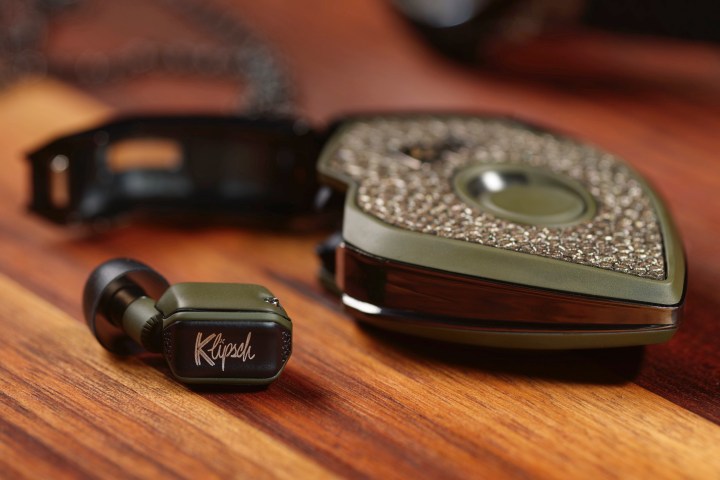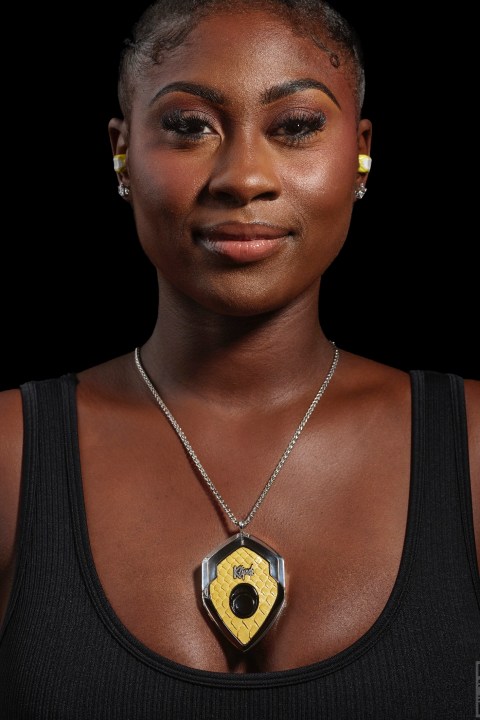Klipsch has joined forces with Ear Micro, a company that creates bespoke wearable tech, to release the T10 Bespoke Ear Computers — a set of noise-canceling wireless earbuds that can be customized by buyers with a huge array of colors, finishes, and materials. Depending on the choices made, a set of T10 earbuds could set you back a whopping $5,000. They can be ordered starting August 17, at t10bespoke.com and can be delivered within a few weeks, according to Ear Micro, which is overseeing the production of the T10.

The T10 are tiny by wireless earbud standards, and their unusually shaped charging case, which features gull-wing access doors on each side, can be worn as a pendant, completing the jewelry vibe the T10 are meant to possess. This is actually not the first time we’ve laid eyes on the T10. Klipsch introduced the earbuds at CES 2020, where they made quite a splash for both their tech and their price.
At that time, Klipsch was planning to release two versions of the T10: a standard model that would cost $649, and a special McLaren edition that would cost $999. Neither model made it to retail during 2020, and it was uncertain whether Klipsch intended to sell them at all. Apparently, the company decided to take a different route, using its partnership with Ear Micro to sell the T10 as the ultimate wearable accessory, though it is still clearly branded as a Klipsch product.

Ear Micro is unapologetic about the T10’s sky-high price, or its target audience. “T10 Bespoke Ear Computers are the ultimate luxury statement,” said Patsy Nigh, co-founder of Ear Micro, in an emailed press release. “Affluent consumers have always been able to collect fine automobiles, yachts, and aircraft, while sporting high fashion, fine eyewear, precious jewelry, and other custom accessories, but to date, they have not been able to purchase true luxury earwear: products that deliver the best sound, the most advanced technology, and the best styling and craftsmanship in the world.”
Beyond the highly visible branding, Klipsch’s contribution to the T10 is mostly to earbud’s sonic architecture, which it borrowed directly from its acclaimed X10 series of in-ear monitors. The T10 Bespoke use the same audio tube and proprietary nozzle, custom-balanced armature and acoustic gasket system, as well as Klipsch’s oval ear tips. Klipsch says that its engineers also worked with Ear Micro to tune the earbuds.
If you’re wondering why they’re called Ear Computers, it’s because Ear Micro has packed an absolutely astonishing amount of technology into these tiny earbuds. Inside each bud is an ARM M4 chip that can run a custom operating system. There are also gyroscopes and accelerometers, which can detect up to six axes of motion, and up to six microphones. The combination can be used for positional awareness, plus the detection of both mouth and head gestures.

Ear Micro has also promised to release a software development kit (SDK) for the T10 that will let third parties create apps and possibly additional accessories that will interact with the T10.
But perhaps the most astonishing thing about the T10 Ear Computers is that they’ve been built like the chassis of a gaming PC. They can be opened using standard tools and each internal component, from the battery to the audio drivers, can be repaired or replaced, according to Ear Micro. That’s almost unheard of in the wireless earbud world, which is essentially comprised of products that must be discarded when any single component fails. Typically, it’s the battery that dies first.
Once you design your T10 using Ear Micro’s customization tool, they are built to order in the U.S. The company says it uses renewable and sustainable materials such as precious metals and ceramic zirconia.
The T10 aren’t shy when it comes to all the usual specifications either. They offer a hybrid active noise cancellation (ANC) system, up to 24-bit/96kHz Bluetooth streaming using Sony’s LDAC codec, and up to nine hours of battery life. Speaking of the battery, Ear Micro claims it hand-builds the power cells for the T10, and they use a laser-welded stainless case that cannot expand or leak.
Digital Trends reached out to Klipsch to see if there are still plans for a non-bespoke version of the T10 in either standard or McLaren editions. A spokesperson told us that Ear Micro is focused on the luxury Bespoke version at this time and does not have a timeline to share on a standard version, they also informed us that they don’t believe there are plans to release a McLaren version.



